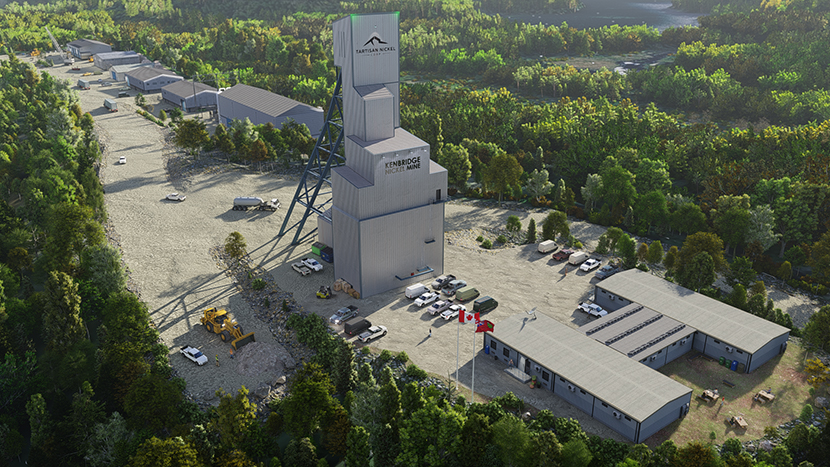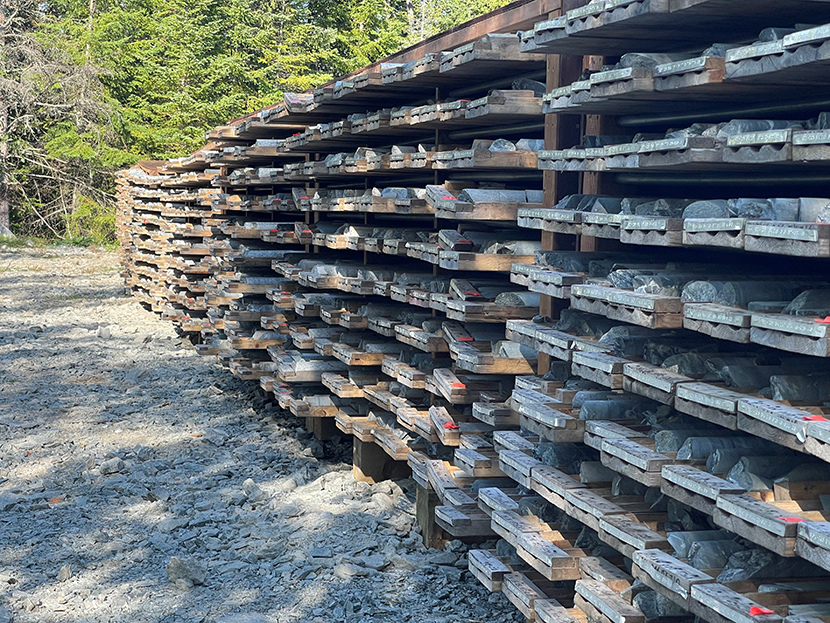JV Article: Tartisan Nickel outlines low-cost underground nickel sulphide mine at flagship Kenbridge project


Following a 10,700-metre drill program completed in late 2021, Tartisan Nickel (CSE:TN; US-OTC:TTSRF) has released a preliminary economic assessment (PEA) for its 100%-owned Kenbridge nickel project in northwestern Ontario’s Kenora Mining District. Prepared by P&E Mining Consultants, the PEA outlines a low-cost, 1,500-t/d operation with a potentially short timeline to production. The study forecasts a nine-year mine plan for the underground mining operation with pre-production capital costs of $133.7 million and a potential start-up within three and a half years.
The low pre-production capital cost and early start-up potential are attributed to the project’s status as a developed prospect with reported resources. It hosts a 622-metre shaft that was sunk in 1954 and has sat idle for 64 years with two working levels. Motivated by the growing demand for battery metals and the transition to electric vehicles (EVs), Tartisan acquired the property in 2018 through a merger with Canadian Arrow Mines.
“We had been looking for an asset to acquire for a few years and came across Canadian Arrow Mines which was trading at a couple of pennies,” recalled Tartisan president and CEO Mark Appleby. “We did some due diligence and put together a deal to take them over through a plan of arrangement. At the time, we were called Tartisan Resources and were a pure play Peruvian company, but we saw the emergence of the electric vehicle revolution and rebranded as Tartisan Nickel.”
The growing awareness of the need to produce battery metals like nickel in an environmentally responsible way favours sulphide nickel deposits, which use much less energy than laterite deposits in the production process. “The Kenbridge project is a sulphide deposit, so that’s a plus for us,” said Appleby.
The Kenbridge project was discovered in 1937 and acquired by Falconbridge in 1952. Falconbridge began construction of the shaft two years later, extracted a bulk sample but then suspended work on the property in 1958.
Dean MacEachern, Tartisan’s geological advisor for the project, had a 20-year career with Falconbridge and was aware of the property from his time managing the company’s Winnipeg exploration office. It was MacEachern who picked it up for Canadian Arrow Mines in 2007.
“The Kenbridge project was part of Falconbridge’s package of ground,” said MacEachern. “Back in the 90s, the price of nickel was US$1.90 per pound and these non-core assets got vended out to various junior mining companies, so this property was on my radar for a while.”
The project is located 70 km southeast of Kenora and has a land position encompassing 42 km2 including a mix of patented and unpatented claims. Work currently underway on a 13-km all-season road to the property is scheduled for completion by year end, grid power is within 40 km of the site and a skilled workforce is locally available in Kenora, Dryden, Fort Frances and neighbouring Indigenous communities.
Since 1937, the property has been tested by 665 surface and underground drill holes totalling 99,741 metres, including 40,000 metres drilled by Canadian Arrow Mines and 10,000 metres drilled by Tartisan in 2021.

“We drilled at depth and along strike to see if we could go deeper than the historical 823-metre hole that was drilled by Falconbridge years ago,” said Appleby. “We drilled down to 1,000 metres plus and discovered that the mineralization does continue at depth and along strike, so we think this is an expandable deposit. In fact, as a result of this drill campaign, we were able to increase the resource by 20%. We also did geophysics on most of the property, including borehole geophysics down existing drillholes, and drilled four holes at a site we call Kenbridge North, three kilometres away. It has similar geophysical and geological characteristics, so it’s possibly a secondary deposit.”
Tartisan has also budgeted for an additional 8,000 plus metres of drilling to continue to test the down-dip extension and bring some of the inferred resource into the indicated category.
The PEA, which is focused solely on the current underground mineral resource, reports 3.4 million tonnes of ore at 0.97% nickel, 0.52% copper and 0.013% cobalt in the measured and indicated categories. Inferred mineral resources total 1.0 million tonnes at 1.47% nickel, 0.67% copper and 0.011% cobalt.
Life of mine revenues from net smelter returns are estimated at $837 million while total capital costs are pegged at $227 million, including $133.7 million to be spent pre-production. The PEA reports an estimated pre-tax net present value of $182.5 million using a 5% discount rate and pre-tax internal rate of return of 26% with payback in 3.5 years.
Kenbridge “is a nickel sulphide, gabbro-hosted deposit similar to deposits that were mined in Lynn Lake, Manitoba, by Sherritt Gordon Mines years ago,” said MacEachern. “At the top, it’s more disseminated and as you go deeper into the zone, it gets more semi-massive and massive. It gets narrower but the grade gets better.”
MacEachern adds that one of the advantages of the project is that the existing infrastructure makes for a modest capex. “It’s under $140 million to get started. That compares with a lot of large low-grade deposits that will take $2 billion to get going.”
Given the project’s low initial capex and short lead time to production, “we look at ourselves as low-hanging fruit,” added Appleby.
According to Tartisan management, the combination of higher-grade zones at depth and lower grade ore near surface offers Tartisan the flexibility to adapt to nickel price fluctuations.
At one point, the management team looked at the possibility of an open pit at surface but came to the conclusion that optimizing it would negatively impact the shaft, so the decision was made to focus on the higher-grade underground material and leave the surface deposits to sometime in the future.
“There are some underground zones that are higher grade that can be brought into the mining plan early,” said MacEachern. “That will allow us to payback the project in a little more than three years and if the price of nickel moves up, so much the better. By focusing on the underground, we alleviate risk if the price of nickel goes down to, say, US$6 per pound.”
According to project manager Greg Edwards, Tartisan has strong support from the three First Nations impacted by the project: Naotkamegwanning First Nation, formerly known as the Whitefish Bay First Nation, Northwest Angle #33 First Nation and Northwest Angle #37 First Nation.
“I meet with them regularly to keep them informed. Last year, we invited several of the local First Nations groups to our site for a lunch and learn, took them on a tour and brought them up to speed on what we were planning. There was also a ceremonial blessing by an elder from one of the communities.”
Anticipating an early start to permitting, Tartisan hired Knight Piesold Consulting and Blue Heron Environmental in May to commence baseline environmental work. A second phase of studies began in August and will continue to cover all four seasons.
The decision to get a jump on the environmental studies reflects the company’s “commitment to an approximate three years to production timeline,” said Appleby.
An on-site mill will produce nickel and copper concentrates that will be shipped by rail or truck to Sudbury or another location for further processing. Also accounted for in the PEA’s pre-production capex plan are the refurbishment of the shaft, the installation of underground infrastructure, and the excavation of 13,000 metres of lateral development.
“Although built in the early '50s and currently flooded, the shaft in very good shape,” said MacEachern. “We dropped a camera down to the bottom and confirmed that it’s in fine condition. The idea would be to slash the shaft out to be able to handle the tonnages we’re looking at. We figure it will take about eight months to get it set up to haul ore. The big advantage for us is that we already have a hole in the ground.”
The preceding Joint Venture Article is PROMOTED CONTENT sponsored by Tartisan Nickel Corp. and produced in co-operation with MINING.com. Visit www.tartisannickel.com for more information.
Comments